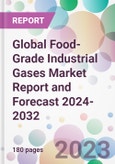According to the report, the global food-grade industrial gases market is projected to grow at a CAGR of 6.1% between 2024 and 2032 reaching a value of approximate USD 13.33 billion by 2032. Aided by the rising demand for packaged foods and the growing importance of food preservation, the market is expected to grow significantly by 2032.
Food-grade industrial gases comprise a set of pure gases such as nitrogen, oxygen, and carbon dioxide that are deemed safe for consumption and are widely used in various stages of food processing, storage, and packaging. These gases play a pivotal role in extending the shelf life of products, ensuring freshness, and maintaining the overall quality of food items. From carbonating beverages to preserving fresh produce and packaged meats, these gases are ubiquitous in the modern food industry.
One of the primary catalysts for the robust growth of the food-grade industrial gases market is the surging demand for frozen and packaged foods. With urbanisation, changing lifestyles, and the increasing pace of life, consumers are inclining towards convenient, ready-to-eat meals. This trend necessitates the use of food-grade gases to maintain the quality and safety of these products over extended periods.
As per the food-grade industrial gases market analysis, the increasing awareness about food wastage and the subsequent emphasis on reducing post-harvest losses have accentuated the importance of food-grade gases. Techniques such as Modified Atmosphere Packaging (MAP) and Controlled Atmosphere Storage (CAS), which employ these gases, have become indispensable in ensuring longer storage life for fruits, vegetables, and other perishable goods.
The beverage industry, too, is a substantial contributor to the food-grade industrial gases market demand. Carbon dioxide is vital in carbonated drinks, giving them their characteristic fizz. With the beverage industry showing no signs of slowing down, this further amplifies the market potential for food-grade carbon dioxide.
Regionally, the North American and European markets, with their mature food and beverage sectors, account for significant portions of the food-grade industrial gases market share. However, the Asia-Pacific region, buoyed by its burgeoning food processing industry and a growing middle class with disposable incomes, is set to emerge as a fast-growing market in the coming years.
Food-grade industrial gases comprise a set of pure gases such as nitrogen, oxygen, and carbon dioxide that are deemed safe for consumption and are widely used in various stages of food processing, storage, and packaging. These gases play a pivotal role in extending the shelf life of products, ensuring freshness, and maintaining the overall quality of food items. From carbonating beverages to preserving fresh produce and packaged meats, these gases are ubiquitous in the modern food industry.
One of the primary catalysts for the robust growth of the food-grade industrial gases market is the surging demand for frozen and packaged foods. With urbanisation, changing lifestyles, and the increasing pace of life, consumers are inclining towards convenient, ready-to-eat meals. This trend necessitates the use of food-grade gases to maintain the quality and safety of these products over extended periods.
As per the food-grade industrial gases market analysis, the increasing awareness about food wastage and the subsequent emphasis on reducing post-harvest losses have accentuated the importance of food-grade gases. Techniques such as Modified Atmosphere Packaging (MAP) and Controlled Atmosphere Storage (CAS), which employ these gases, have become indispensable in ensuring longer storage life for fruits, vegetables, and other perishable goods.
The beverage industry, too, is a substantial contributor to the food-grade industrial gases market demand. Carbon dioxide is vital in carbonated drinks, giving them their characteristic fizz. With the beverage industry showing no signs of slowing down, this further amplifies the market potential for food-grade carbon dioxide.
Regionally, the North American and European markets, with their mature food and beverage sectors, account for significant portions of the food-grade industrial gases market share. However, the Asia-Pacific region, buoyed by its burgeoning food processing industry and a growing middle class with disposable incomes, is set to emerge as a fast-growing market in the coming years.
Market Segmentation
The market can be divided based on type, application, end use, mode of supply, and region.Market Breakup by Type
- Carbon Dioxide
- Nitrogen
- Oxygen
- Others
Market Breakup by Application
- Freezing and Chilling
- Packaging
- Carbonation
- Others
Market Breakup by End Use
- Beverages
- Meat, Poultry, and Seafood Products
- Dairy and Frozen Products
- Fruits and Vegetables
- Convenience Food Products
- Bakery and Confectionery Products
- Others
Market Breakup by Mode of Supply
- Bulk
- Cylinder
Market Breakup by Region
- North America
- Europe
- Asia Pacific
- Latin America
- Middle East and Africa
Competitive Landscape
The report looks into the market shares, plant turnarounds, capacities, investments, and mergers and acquisitions, among other major developments, of the leading companies operating in the global food-grade industrial gases market. Some of the major players explored in the report are as follows:- Linde Plc
- Air Products and Chemicals, Inc.
- Air Liquide S.A.
- Messer Group GmbH
- Taiyo Nippon Sanso Corporation
- SOL Group
- Others
Table of Contents
1 Preface2 Report Coverage - Key Segmentation and Scope4 Key Assumptions7 Opportunities and Challenges in the Market15 Value Chain Analysis16 Price Analysis18 Key Trends and Developments in the Market
3 Report Description
5 Executive Summary
6 Snapshot
8 Global Food-Grade Industrial Gases Market Analysis
9 North America Food-Grade Industrial Gases Market Analysis
10 Europe Food-Grade Industrial Gases Market Analysis
11 Asia Pacific Food- Grade Industrial Gases Market Analysis
12 Latin America Food-Grade Industrial Gases Market Analysis
13 Middle East and Africa Food-Grade Industrial Gases Market Analysis
14 Market Dynamics
17 Competitive Landscape
List of Key Figures and Tables
Companies Mentioned
- The Linde Group
- Air Products & Chemicals Inc. (NYSE: APD)
- Air Liquide (EPA: AI)
- The Messer Group GmbH
- Taiyo Nippon Sanso (TYO: 4091)
- SOL Group (BIT: SOL)
Methodology

LOADING...








